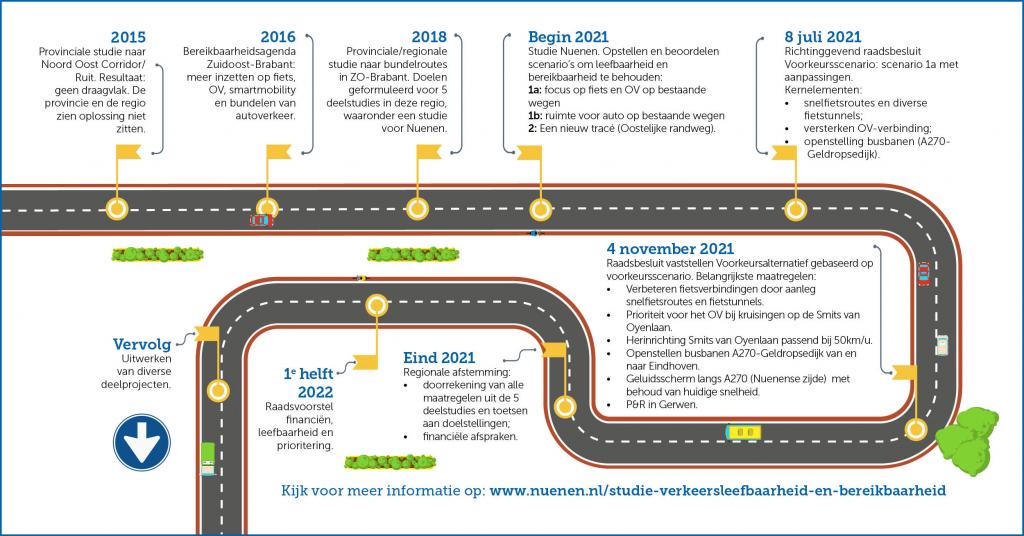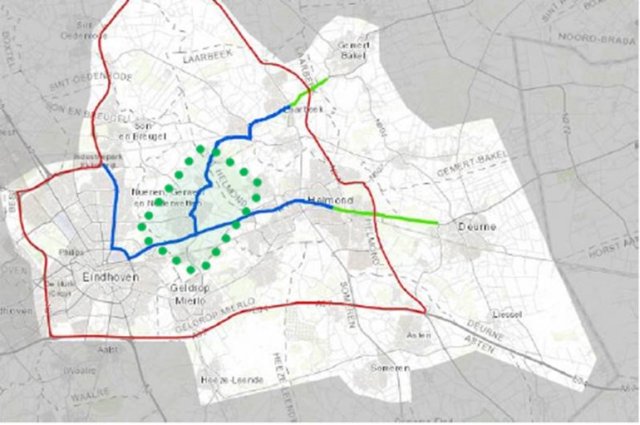Livable and accessible Nuenen
Increasing traffic is worsening the traffic livability and accessibility in Nuenen. We don't want that to happen. That is why the municipality, together with the Province of North Brabant, investigated this. A cohesive package of measures was then determined together with various parties. This package consists of 10 cohesive projects. Implementation of these projects will ensure that Nuenen's traffic livability and accessibility are maintained and in some areas even improved.
The package of measures was created through a participatory process in which various parties participated. Now begins the phase in which the projects are worked out, prepared and tendered. Here too, participation will take place with the parties involved. We are looking at which forms fit best here. Implementation of the first 3 projects is expected to start in 2027.
Participation cluster South (first three subprojects).
Cluster South is the first part to be developed. This cluster involves the three subprojects:
- Opening bus lanes Geldropsedijk - A270 to motorized traffic
- Construction of noise protection facility north side A270 (between Geldropsedijk - Smits van Oyenlaan)
- Redesign of Smits van Oyenlaan (southern section).
Participation meeting July 1, 2025
On Tuesday, July 1, 2025 was the first participation meeting on the projects in cluster South, organized by the municipality of Nuenen and BAM Infra. The meeting focused on the development of the first three projects in Nuenen South. The meeting began with a presentation on the three projects. The landscape exploration of the area was also discussed. During the second part of the meeting, input was gathered at thematic tables. Attendees could express their concerns, opportunities and possible worries. The project team is now taking this input into further elaboration of the plans.
Presentation meeting July 1, 2025 (pdf)
Sounding board session Aug. 28, 2025
The sounding board session was held on Thursday evening, August 28, 2025. The selected sounding board group members gave their opinions on the proposed variants of the three projects at the three thematic tables. The design team will take this input into the development of the preferred variants.
Presentation sounding board session Aug. 28, 2025 (pdf)
Information meeting preferred alternatives Nov. 25, 2025
On Tuesday evening, November 25, 2025, the presentation of the preferred variants of the three subprojects took place. Residents of Nuenen South and other interested parties were present.
Presentation preferred alternatives cluster South Nov. 25, 2025 (pdf)
Elaboration of subprojects
The measures are divided into several subprojects. These include the following subprojects:
Opening of bus lanes Geldropsedijk - A270 to motorized traffic
We will open the existing bus lanes via the Geldropsedijk - A270 slip road to motorized traffic. This will improve Nuenen's accessibility and allow us to better distribute and control traffic in Nuenen. Naturally, safety is an important issue in the design of the new traffic situations. This also applies to the flow of public transport.
Narrowing Smits van Oyenlaan (south)
The consequence of the package of measures (in particular the opening of the A270 bus lanes) is that there will be slightly less traffic on Smits van Oyenlaan (between Klamperlaan traffic circle and the A270 junction). By narrowing the road here to a single lane, the road is better suited to the permitted speed of 50 km/h. A double lane in fact gives the impression that faster driving is allowed. So the narrowing will not change the legal speed, but the new design will increase traffic livability and safety. It also creates opportunities for a different (greener) use of the vacant space.
Construction of noise barrier on north side of A270 motorway
We are placing a noise barrier along the A270 (section between Smits van Oyenlaan and Geldropsedijk on the north side of the A270). We do this because it provides a great local improvement in the quality of life (noise). There are various possibilities for the noise barrier provision.
Snelfietsroute Gemert - Eindhoven- first part from municipal border Eindhoven to traffic circle 't Pluuke (Europalaan - Smits van Oyenlaan)
Gemert - Eindhoven express cycle route - second part & modifications Smits van Oyenlaan
- The express bike route part two goes from Pluuke traffic circle to N615 (Lieshoutseweg).
- The intersections on Smits van Oyen Avenue will be modified at a number of points, including traffic lights.
- In Gerwen there will be a village hub: a hub where different types of transportation come together.
Planning
Completed: Problem analysis, scenarios, sketch designs and decision - 2015 -2021
During the study we investigated the traffic livability and accessibility of the municipality of Nuenen. The study resulted in a realistic preferred alternative of (traffic) measures, supported by the province and municipality, with a sketch design and a rough cost estimate.
Completed: Administrative agreement and development of subprojects - 2023
The Province has reserved a contribution of €10 million for the Nuenen preferred alternative (VKA) Bundelroutes. The Regional Mobility Program stipulates that this amount will accrue to Nuenen for the realization of the VKA under the first condition that both parties enter into a management agreement (BOK).
Completed: Preparation of tender for subprojects 1 to 3 - second half 2024
The tender for the contractor for subprojects 1 to 3 has been completed. BAM Infra has been selected as the party to do the preparation and possibly execute the projects.
Completed: Concluding management agreement snelfietsroute Gemert - Eindhoven - April 2025
In early April 2025 the municipalities of Nuenen, Eindhoven, Laarbeek, Gemert-Bakel and the province of North Brabant signed the Administrative Agreement (BOK) for the express cycle route between Gemert and Eindhoven. This agreement contains agreements on the financing and realization of the express cycle route. Read more in the news item.
Currently underway: Forming construction team, elaboration and design for subprojects 1 to 3 - first half 2025
In the first half of 2025, the construction team for subprojects 1, 2 and 3 will be formed. From then on, the elaboration and design of the projects will become more concrete.
Currently underway: Participation subprojects 1 to 3 - mid 2025
Together with stakeholders, we will look at how best to implement subprojects 1 through 3. On July 1, 2025 was the first participation meeting. On August 28, 2025 was the sounding board group meeting. On November 25, 2025, the preferred variants were presented.
Still to do: Participation subproject express bicycle route section from from Pluuke traffic circle to N615 - mid 2025
Together with stakeholders, we will look at how best to set up subproject 4.
Still to be done: Start work on subprojects 1 to 3 - second half of 2026
Work on the first 3 subprojects is expected to take place starting in the second half of 2026.
Still to be done: Start work on subproject 4 - end of 2026
Work on subproject 4 is expected to take place beginning in late 2026.
Related documents
Downloading and opening a document
You can open a PDF file in various PDF readers, such as Adobe Reader.

